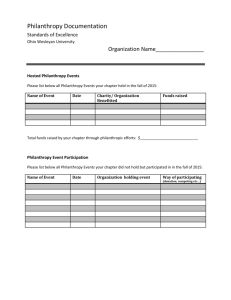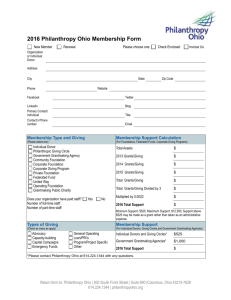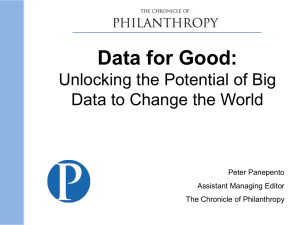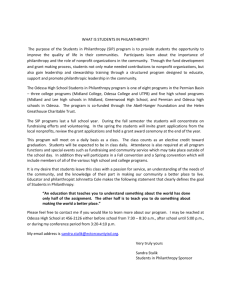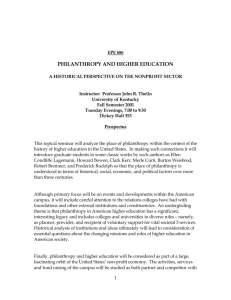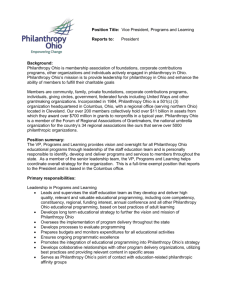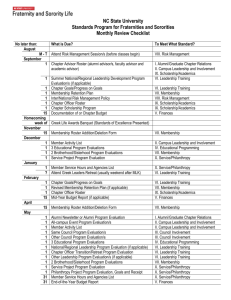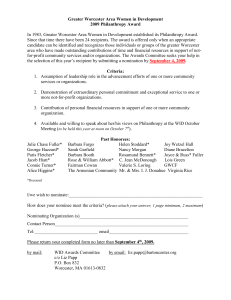Board Development Slides Handout
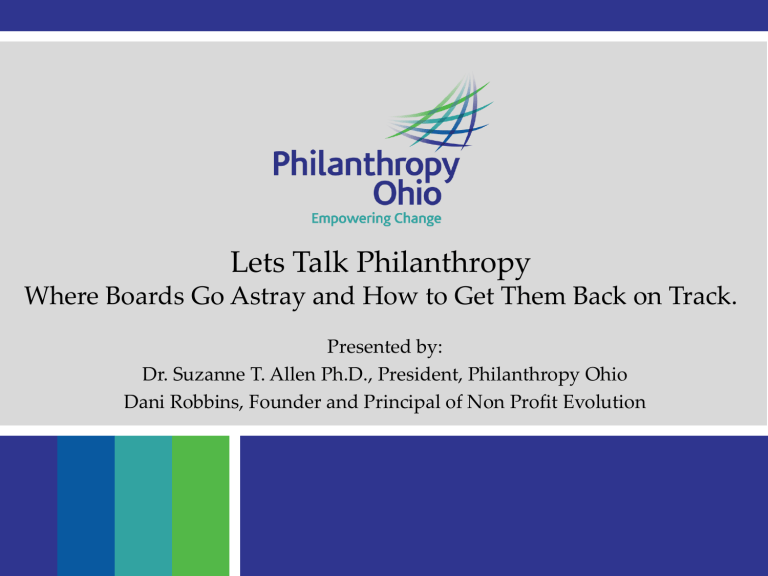
Lets Talk Philanthropy
Where Boards Go Astray and How to Get Them Back on Track.
Presented by:
Dr. Suzanne T. Allen Ph.D., President, Philanthropy Ohio
Dani Robbins, Founder and Principal of Non Profit Evolution
Let’s Talk Philanthropy
Dr. Suzanne T. Allen Ph.D.
President,
Philanthropy Ohio
Let’s Talk Philanthropy
Dani Robbins
Founder and Principal of
Non Profit Evolution
Session Goals
• Learn the most common ways boards become dysfunctional
• Set expectations for board members and reinforce those expectations with board evaluations and;
• Dive deeper into ways to build a high functioning board
Common Board Issues
Lack of Understanding of their Role, the Board’s Role and the role of the CEO
“I’m a Volunteer”
Allowing the Unacceptable
Unengaged Members
I’m a Volunteer
How this happens:
– Too much pressure for board service
– Expectations not clear when asked to join the
Board
– Time commitment not communicated
– Board members not trained to their role
Possible Solutions:
– Job description
– initial discussion, orientation annual trainings
– expectations all include the need to “be prepared to meet as often as is necessary to complete the business of the board during the term of one’s service”
Lack of Understanding
How it happens
– In the absence of a formal plan to perpetuate and educate your board, you will be at the mercy of whoever proceeded you, at whatever agency your board members served previously
– Not all volunteers are created equal
– Lack of understanding of budget/financials
– Fear
– Lack of information
– Unwillingness to question
How to address it:
– Have the right mix on board
– Budget by activity
– Funding a part of every new idea discussion
– Orientation to include encouragement to speak up and never vote for something you do not support
– Robust discussion at Board meetings
– Encouragement to ask for more information
Allowing the Unacceptable
How this happens:
– Don’t want to over step
– Don’t know how to fulfill role
– Don’t understand what is acceptable
– Rubber stamp
– Conflict avoidance
– Fear
Possible Solutions:
– Policy on acceptable practices
– Define duties
– Create an environment conducive to discussion
– Encouraging robust discussion
– Orientation to include discussion of disagreement and encouragement to not vote on motions with which members disagree
– Policies to remove problematic members
Unengaged Board Members
How this happens:
• Executive Committee or
Management takes away all real thinking and responsibility
• Wrong people on the board
• No plan
• Disorganized meetings
• Strong Board members get frustrated and quit
• Lack of clarity of authority
• And….I hate to say it…the
CEO builds it that way
How to address it:
– Eliminate the power of the Executive
Committee to vote in lieu of the full board
– Define duties and responsibility
– Training on the role of the board and the role of the CEO
– Strategic Plan
– Clear assignments
– Task mastery
Board Development :
How to get where you want from where you are
Boardsource
Board Roles and Responsibilities
Mission, Vision and Strategic Planning
Hire, Support and Evaluate Executive Director/CEO
Fiduciary Responsible Agent
Policy Setting
Securing Resources/ Fund
Raising, as applicable
Mission, Vision and Strategic Planning
• The mission statement answers why an organization exists.
• A vision is a description of what the organization will look like at a specified time in the future.
• Strategic planning is a process by which the board, staff, and select constituents, decide the strategy for the future direction of an organization and allocate resources, including people, to ensure that target is reached.
Hire, Support and Evaluate the CEO
• Hire for what your organization needs in a Leader
• Support, meet with, make introductions
• Annual Evaluations – often linked to strategic plan
• Succession Planning
Fiduciary Responsible Agent
• Read, understand and approve the financials
• Review, understand and approve the audit, as appropriate
• Review and sign the 990
• Understand how the programs tie to the mission and the number of people served in those programs as well as the program's impact
Policy Setting
• Personnel
• Financial
• Whistle blower, Ethics/Conflict of interest
• Others relevant to field or community
Securing Resources/Fund Raising
When serving on the board of an agency that raises contributed income:
The Committee is responsible for creating and executing a plan to raise money.
The full Board is responsible for introducing their network to the organization, attending events, financially supporting the organization and encouraging other to do as well.
Expectations of Board Members
• Attend at least 75% of
Board Meetings
• Serve on at least one
Committee
• Represent Organization in the community at large
• Set and uphold policies, procedures and ethical standards of organization
• Attend events and encourage others to do so
• Give a personally significant financial gift
• Solicit additional gifts
• Introduce Organization to
Board member’s circle of influence
• Work for the betterment of
Organization
Identification Options
• What skill sets do you need?
• How diverse is your Board?
• How high profile is your Board?
• Who is in your pool of candidates?
• Are there community leaders you would love to have in a perfect world? How can you start cultivating those people?
• Matrix mapping to insure diversity of thought
• Additional options?
Matrix Mapping
Occupation
Professional Experience
Social Network
Skills Set
Network
Ability
Experience
Race
Religion
Gender
Age
Evaluation
• Evaluation is a developmental process, not a report card.
• The Board Development Committee is responsible for giving the individual board members and the entire board opportunities for evaluation and reflection.
• Options:
– Self Evaluations against Expectations
– Committee individually evaluates members against Expectations
– May lead to removal of Board members
Recognition
Board members should be treated like donors… plus!
Nomination for local awards- AFP, Chamber,
Community Foundation
Articles in newsletter, local paper, etc.
Move your Board forward
• Talk with your Board about what they want, about why they joined, and what they hoped to get out of their service.
• Call a retreat.
• Take a survey.
• Add some impact stories to the agenda.
• Have a Strategic Planning Strategy session and then continue to talk strategy throughout the year.
• Present a environmental scan and discuss how it will impact your clients, not just your agency, but your clients.
• Introduce some generative discussions at board meetings.
Take 3 minutes and write down 3 things you can do to move your Board
From: where it is
To: where you’d like it to be
Thank you for attending!
Stay tuned for:
• High Impact Corporate Community
Involvement
– Webinar: June 17 at 9am
• Demystifying Funder Transparency,
Focusing on Communicating Well
– Webinar: June 25 at 12pm
• Financial Administration Excellence
Course for Community Foundations
– Aug 20 th Detroit, MI
• Philanthropy Ohio’s Summer Institute
– The Blackwell Center @ The Ohio State
University on July 9 th , 2014
2 Summer Institute
Sessions with BoardSource
®
• Improve your board chair-CEO relationship
• Better identify and engage board members
• Learn how to orchestrate strategic-level change Member Rate: $250 philanthropyohio.org/summerinstitute
• Put governing more, managing less, into practice
• Huge savings vs. private BoardSource® session
Connect with us!
Facebook.com/philanthropyohio
Twitter.com/philanthropyOH (#OHphilTalks)
Linkedin.com/company/philanthropyohio
